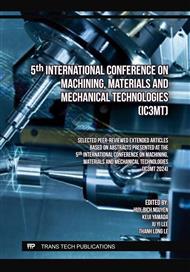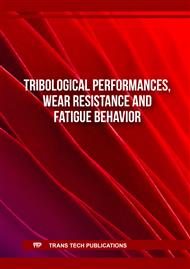p.39
p.45
p.53
p.61
p.69
p.75
p.83
p.93
p.107
Influence of Heat Treatment on Tool Wear of High-Carbon Steel (C55)
Abstract:
Many of the previous studies on cutting properties have compared various steels with a same heat treatment, and there are almost no studies that focus on the differences in heat treatments of a same material. In this report, the influence of different heat treatments on tool wear of high-carbon steel (C55) is experimentally investigated in turning process. This study focused on three heat treatments: quenching and tempering, normalizing, and spheroidization annealing. We divided flank wear into 3 areas (corner, middle area and groove wear) for observation and analyzed each characteristic. It is found that for C55, regardless of heat treatment types, wear at the corner of the insert tip is highly dependent on cutting speed, whereas the dependence is lower where it is far away from the corner. This result is considered to be due to the adhesion that occurs while cutting. Therefore, selecting the cutting speed that minimizes flank wear at the corner can control tool wear and extend tool life. In terms of real-time monitoring for tool replacement, the correlation coefficient between the flank wear and the sensing data (spindle current, feed-axis servo motor current, and cutting sound) is also considered to depend on the adhesion condition at the insert tip. If adhesion occurs, the correlation coefficient is not stable and it’s likely to be difficult to predict wear trend to check the end of a tool life. Adhesion makes tool wear prediction using the sensing data difficult.
Info:
Periodical:
Pages:
69-74
Citation:
Online since:
March 2025
Authors:
Keywords:
Price:
Сopyright:
© 2025 Trans Tech Publications Ltd. All Rights Reserved
Share:
Citation:



